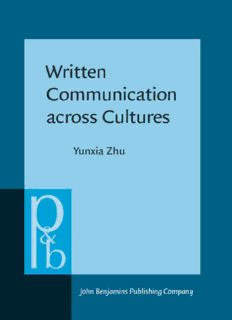
Written Communication Across Cultures: A Sociocognitive Perspective on Business Genres PDF
Preview Written Communication Across Cultures: A Sociocognitive Perspective on Business Genres
<DOCINFOAUTHOR""TITLE"WrittenCommunicationAcrossCultures:Asociocognitiveperspectiveonbusinessdiscourse"SUBJECT"Pragmatics&Beyond,NewSeries,Volume141"KEYWORDS""SIZEHEIGHT"240"WIDTH"160"VOFFSET"4"> WrittenCommunicationacrossCultures Pragmatics&BeyondNewSeries Editor AndreasH.Jucker UniversityofZurich,EnglishDepartment Plattenstrasse47,CH-8032Zurich,Switzerland e-mail:[email protected] AssociateEditors JacobL.Mey UniversityofSouthernDenmark HermanParret BelgianNationalScienceFoundation,UniversitiesofLouvainandAntwerp JefVerschueren BelgianNationalScienceFoundation,UniversityofAntwerp EditorialBoard ShoshanaBlum-Kulka CatherineKerbrat-Orecchioni HebrewUniversityofJerusalem UniversityofLyon2 JeanCaron ClaudiadeLemos UniversitédePoitiers UniversityofCampinas,Brazil RobynCarston MarinaSbisà UniversityCollegeLondon UniversityofTrieste BruceFraser EmanuelSchegloff BostonUniversity UniversityofCaliforniaatLosAngeles ThorsteinFretheim DeborahSchiffrin UniversityofTrondheim GeorgetownUniversity JohnHeritage PaulO.Takahara UniversityofCaliforniaatLosAngeles SandraThompson SusanHerring UniversityofCaliforniaatSantaBarbara UniversityofTexasatArlington TeunA.VanDijk MasakoK.Hiraga PompeuFabra,Barcelona St.Paul’s(Rikkyo)University RichardJ.Watts DavidHoldcroft UniversityofBerne UniversityofLeeds SachikoIde JapanWomen’sUniversity Volume141 WrittenCommunicationacrossCultures:Asociocognitiveperspectiveon businessgenres byYunxiaZhu Written Communication across Cultures A sociocognitive perspective on business genres Yunxia Zhu UniversityofQueensland,Australia JohnBenjaminsPublishingCompany Amsterdam(cid:1)/(cid:1)Philadelphia TM Thepaperusedinthispublicationmeetstheminimumrequirements 8 ofAmericanNationalStandardforInformationSciences–Permanence ofPaperforPrintedLibraryMaterials,ansiz39.48-1984. LibraryofCongressCataloging-in-PublicationData YunxiaZhu WrittenCommunicationacrossCultures:Asociocognitiveperspectiveon businessgenres/ YunxiaZhu. p. cm.(Pragmatics&Beyond,NewSeries,issn0922-842X;v.141) Includesbibliographicalreferencesandindexes. 1.Interculturalcommunication.2.Businesscommunication.3. Writtencommunication.4.Englishlanguage--Discourseanalysis.5. Chineselanguage--Discourseanalysis.I.Title.II.Series. P94.6.Z48 2005 302.2’244--dc22 2005050765 isbn9027253846(Hb;alk.paper) ©2005–JohnBenjaminsB.V. Nopartofthisbookmaybereproducedinanyform,byprint,photoprint,microfilm,or anyothermeans,withoutwrittenpermissionfromthepublisher. JohnBenjaminsPublishingCo.·P.O.Box36224·1020meAmsterdam·TheNetherlands JohnBenjaminsNorthAmerica·P.O.Box27519·Philadelphiapa19118-0519·usa TSL[v.20020404] Prn:26/09/2005;13:39 F:PB141CO.tex / p.1(v) Table of contents Listoffigures xi Listoftables xiii Notationconventions xv Preface xvii Chapter1 Introductionandoutline 1 Thetheoreticalimperatives 2 Therationale,aim,andresearchquestions 4 Theoutlineofthebook 6 Chapter2 Communicationacrosscultures 9 Contrastiverhetoric 9 ClassicalGreekandChineserhetoricaltraditions 12 Interculturalcommunication 15 Guanxi andinterculturalbusinesscommunication 17 Cross-culturalpragmatics 17 Faceandpolitenessbehaviour 20 Australian,NewZealandandtheChinesecultures 23 Summaryofthecross-culturaldimensions 24 Chapter3 Conceptualframework:Adualperspective 27 Introducingthesociocognitivestudyofgenre 28 Genreasrelevant“socialstockofknowledge” 29 Genreandthesocioculturalcontexts 32 Genrepracticeandthediscoursecommunity 34 Genreascommunicativeevents 39 Genreandcommunicativepurposes 39 TSL[v.20020404] Prn:26/09/2005;13:39 F:PB141CO.tex / p.2(vi) WrittenCommunicationAcrossCultures Genreandrhetoricalstructure 41 Genreandintertextuality 43 TheChinesegenreapproach 45 HistoricalreviewofChinesegenrestudy 47 LiuXie’sviewonChinesewrittendiscourse 47 LiuXie’sapproachtogenrestudy 50 ModernChinesegenrestudy 51 Yingyongwen andgongwen genrestudy 52 Proposingthemodelforcross-culturalgenrestudy 57 Chapter4 Researchdesign 61 Theresearchmethod 61 Data 63 Questionnaireandinterviews 64 Theparticipants 64 Thequestionnaire 66 Theinterviews 67 Dataanalysis 69 Chapter5 ComparingEnglishandChinesesalesletters 71 Socioculturalcontextsforsales-letterwriting 72 ThecontextsandworldschemataforEnglishsalesletters 72 ThecontextsandworldschemataforChinesesalesletters 74 Communicativepurposesandpersuasiveorientations ofsalesletters 76 Comparingtextsofsalesletters 78 Intertextualityandrhetoricalstructureinsalesletters 78 DifferentmovesemployedbyEnglishandChinese salesletters 81 SimilarmovesemployedbyEnglishandChinese salesletters 86 Summaryofthetextualanalysis 91 ThemosteffectiveEnglishandChinesesalesletters 92 TheEnglishletter 92 TheChinesesalesletter 95 Conclusion 98 TSL[v.20020404] Prn:26/09/2005;13:39 F:PB141CO.tex / p.3(vii) Tableofcontents Chapter6 ComparingEnglishandChinesesalesinvitations 101 Contextsforwritingsalesinvitations 102 Otherculturalfactors:Politenessbehaviourininvitations 103 Communicativepurposesandpersuasiveorientations ofsalesinvitations 105 AnalysingtheEnglishandChinesesalesinvitations 106 Intertextualityreflectedinsalesinvitations 106 Intertextualityandrhetoricalstructure ofsalesinvitations 107 Analysingthemosteffectivesalesinvitations 110 IntroducingtheExpoandinvitingthereader 112 AdvertisingtheExpo 114 Offeringincentives 115 Invitingagain 116 Providingregistrationdetails 117 Encouragingfurthercontact 117 Politeclosing 117 Summaryoffindingsonsalesinvitations 118 ComparingNZandChinesemanagers’views onsalesinvitations 119 Managers’viewsontheEnglishinvitation 119 Managers’viewsontheChineseinvitation 120 Conclusion 122 Chapter7 ComparingEnglishandChinesebusinessfaxes 123 DataoftheEnglishandChinesefaxes 124 Technologicalandsocioculturalcontextsforfaxwriting 125 Introducingfaxasagenre 127 Persuasiveorientationsandcommunicativepurposes ofbusinessfaxes 130 Anoverviewoftypesofintertextualityidentifiedinfaxes 131 Rhetoricalstructuresidentifiedinbusinessfaxes 133 Greetingsusedinfaxes 135 Referencetopreviouscommunication/contact 135 Establishingcredentials 137 Givinginformation 137 Detailingtheorder 138 TSL[v.20020404] Prn:26/09/2005;13:39 F:PB141CO.tex / p.4(viii) WrittenCommunicationAcrossCultures Confirmationmove 139 Givingproductdetails 139 Complaint 140 Threattochangeterms 142 Stressingcooperation 143 Politeclosing 144 Goodwishes 145 ThemosteffectiveEnglishandChinesefaxes 146 Conclusion 152 Chapter8 Cross-culturalgenreteaching:Actionsandimplications 155 Issuesrelatingtocross-culturalgenreteaching 156 Genremetaphors 156 Genreteachingapproaches 157 Genericcompetence 158 Applyingthesociocognitiveapproachtoteachingandlearning 161 Illustratingthefiveteachingandlearningprocesses 163 Theexperiment 163 Learningandcomparingthesocioculturalcontexts 165 Learningpersuasiveorientationsand communicativepurposes 165 Learningtowritetextsandincorporating peripheralparticipation 167 Usingauthenticdataandincorporatingmanagers’views 170 Learningtheimplicationsforcross-cultural genericcompetence 173 Conclusion 175 Chapter9 Summariesandconclusions 177 Defininggenrefromacross-culturalperspective 178 Summaryofsignificantfindings 179 Theframework 179 Genreandsocioculturalcontexts 180 Genre,persuasiveorientationsand communicativepurposes 180 Genreandits“deepsemantics” 181 Genreandintertextuality 182 TSL[v.20020404] Prn:26/09/2005;13:39 F:PB141CO.tex / p.5(ix) Tableofcontents Genreascollectivelyprogrammedby thediscoursecommunity 183 Genericcompetenceacrosscultures 184 Implicationsforgenreresearchandinterculturalcompetence 185 Furtherresearch 186 Closingremarks 187 References 189 Appendix 203 Nameindex 209 Subjectindex 213
Description: